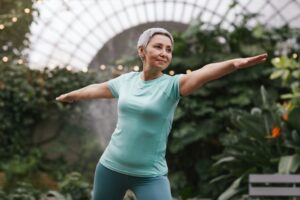Guest Blog: Exploring active wear for boomer generation
Introduction:
Whether you’re trying to get in shape after years of being sedentary or have always been active, it’s important that you make sure that your clothes are functional.
It’s also important to wear clothes that are comfortable and appropriate for your activity level. Not only will this make exercising more enjoyable but it will also help prevent injuries while working out.
Active wear is available in a wide variety of styles and colors, making it easy to find something that suits your own personal tastes. Here are some tips on how you can choose the right fitness gear:
The benefits of wearing active wear:
In addition to being comfortable and functional, active wear is also versatile. You can wear your activewear for any type of workout, whether you’re hitting the gym or working out at home. Activewear is stylish, yet functional–and it can help you feel confident and look great!
The options for active wear are endless:
When it comes to active wear, the options are endless. There are so many different styles and colors that you can choose from that you may find yourself overwhelmed by all of your choices. That’s okay though! You don’t have to pick just one kind of sportswear–you can mix and match different pieces with each other depending on what activity you’re doing or where you’re going. For example, if I’m going hiking in the mountains I’ll probably wear jeans with some hiking boots (or sneakers if it’s not too muddy), and you can order best boots for men or women online too, but if I’m going mountain biking then I would wear shorts and knee pads instead because they’re more comfortable when riding bikes!
Boomers are wearing more color and patterns than ever before:
As you age, it’s important to maintain your sense of style. While you may have worn all black in your younger years, now that your part of the boomer generation, it’s time to express yourself through color and patterns!
Color is a great way to express your personality–and if you don’t like how something looks on someone else? The answer is simple: wear it yourself along with stylish MK bags! Patterns can also be used as an expression of individualism–and boomers aren’t afraid to stand out from the crowd.
There are many choices when it comes to active wear in every size:
When it comes to active wear, there are plenty of choices for every boomer generation. There are many brands and styles, as well as sizes available. You can find active wear in any color or pattern, style and size–even if you’re looking for something special. You can buy bodybuilding stringer tank tops or gym trousers or shorts online too!
Plus-size options are becoming more readily available in the market:
Plus-size options are becoming more readily available in the market. This is a positive development for the boomer generation, who are no longer limited to one or two active wear brands. There are many options for boomers to choose from, including brands like Athleta and Lululemon that cater to older women with their unique designs and styles. The good news is that there’s an abundance of choices out there now so you don’t have to settle on just one brand or style!
Active wear is available with a variety of styles for all body types:
Active wear is available in a variety of styles, sizes and colors. It’s important to remember that active wear isn’t just for people who are physically active. If you’re looking for something more casual or want to wear your favorite pair of jeans, there are plenty of options out there that won’t make you feel like an old fuddy-duddy.
Active wear helps you feel comfortable and confident:
Active wear is the perfect combination of fashion and function, making it a great choice for older adults. Active wear can be used to make a bold fashion statement while also being functional during workouts. Activewear is designed to fit the body, providing comfort and functionality during athletic activity. Activewear comes in a variety of styles suited for all body types or ages.
Want to start moving your body, this is the article for you.
If you’re a boomer and want to start moving your body, this is the article for you.
You’ve probably heard about how important it is for people to keep moving as they age–and it’s true: regular physical activity can help improve your health, reduce stress and increase happiness. But if it feels like there are so many things in life that need your attention that finding time for exercise seems impossible? That feeling isn’t unusual! The key is starting small with simple activities like walking or gardening that fit into your daily routine.
Here are some tips for getting started on this journey:
- Wear clothes that feel comfortable when exercising–the right gear will help motivate you throughout the day!
- Don’t forget sunscreen! Age spots aren’t just something we see in photos anymore; they’re real and they will occur if unprotected skin gets too much sun exposure over time.
- If possible, try scheduling workouts around other activities such as taking care of kids/grandkids or volunteering at church/school events – these kinds of things provide extra motivation because they remind us why getting active matters so much (and give us something else fun/productive).
Add some new gear when comfortable with your exercise routine:
When you’ve gotten comfortable with your exercise routine, it’s time to start thinking about how to make the experience more enjoyable. In addition to finding new exercises that are right for your body and fitness level, there are also some other things you can do:
Gear: If you want a little extra help with your workout, consider buying some gear. For example, if running is difficult for you because of knee pain or back problems (or any other reason), then an elliptical machine may be better suited for these areas than running would be. Or maybe an adjustable weight bench will give those biceps a boost! On the other hand, don’t waste money on something like a yoga mat unless it’s going to make things easier or more fun–and even then only get one if there’s room in the budget!
Active wear can be a bold fashion statement and also functional during workouts:
When you think of active wear, what comes to mind? Do you see the same old gym clothes that have been around since you started working out in high school? Or maybe it’s those yoga pants that have become your uniform for all things work out-related. While there’s nothing wrong with these staples, active wear can be used to make a bold fashion statement while also being functional during workouts.
The options for active wear are endless and include everything from colorful leggings or sports bras to printed tops and jackets! Boomers are wearing more color and patterns than ever before because they want their clothes to be fun without sacrificing function. There are many choices when it comes to active wear in every size so everyone can participate in this trend whether they’re into running marathons or just trying something new at their neighborhood gym class (and yes–there is such thing as “gym class”).
Conclusion
Active wear is a great way to stay active and look good. It’s also important for you to remember that you don’t need to spend a lot of money on new clothes or equipment; there are plenty of options out there that won’t break the bank!



